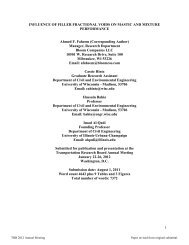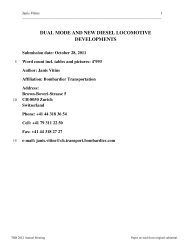Evaluation of Lime Kiln Dust as a Mineral Filler in Stone Matrix Asphalt
Evaluation of Lime Kiln Dust as a Mineral Filler in Stone Matrix Asphalt
Evaluation of Lime Kiln Dust as a Mineral Filler in Stone Matrix Asphalt
You also want an ePaper? Increase the reach of your titles
YUMPU automatically turns print PDFs into web optimized ePapers that Google loves.
West and James 3<br />
<strong>in</strong>clud<strong>in</strong>g soil condition<strong>in</strong>g and stabilization, <strong>in</strong>dustrial w<strong>as</strong>te stabilization, Portland cement<br />
production, and agricultural uses. Unused LKD is usually stockpiled near the lime plant but can<br />
be disposed <strong>of</strong> <strong>in</strong> approved landfills.<br />
C<strong>as</strong>e Studies <strong>of</strong> the Use <strong>of</strong> <strong>Lime</strong> <strong>Kiln</strong> <strong>Dust</strong> <strong>as</strong> a <strong>M<strong>in</strong>eral</strong> <strong>Filler</strong> <strong>in</strong> SMA<br />
Alabama<br />
<strong>Lime</strong> kiln dust w<strong>as</strong> used <strong>in</strong> several SMA projects <strong>in</strong> Alabama between 2001 and 2002.<br />
Accord<strong>in</strong>g to the Alabama Department <strong>of</strong> Transportation, a number <strong>of</strong> these SMA projects<br />
exhibited discolored surfaces soon after construction. The discoloration w<strong>as</strong> generally observed<br />
<strong>as</strong> a blotchy grey color. One Alabama project with lime kiln dust did result <strong>in</strong> more significant<br />
pavement problems. This SMA project w<strong>as</strong> constructed on Highway 80 <strong>in</strong> Selma, Alabama <strong>in</strong><br />
the summer <strong>of</strong> 2002. This project w<strong>as</strong> <strong>in</strong>tended to correct significant rutt<strong>in</strong>g on this heavy<br />
trafficked section <strong>of</strong> roadway. The exist<strong>in</strong>g rutted pavement w<strong>as</strong> milled five <strong>in</strong>ches and two<br />
layers <strong>of</strong> SMA were placed to complete the reconstruction. The first layer w<strong>as</strong> a 1-½ <strong>in</strong>ch<br />
Maximum Aggregate Size (MAS) SMA which w<strong>as</strong> placed 3 to 3.5 <strong>in</strong>ches thick. The surface<br />
layer w<strong>as</strong> a ½ <strong>in</strong>ch MAS SMA that w<strong>as</strong> placed 1.5 to 2 <strong>in</strong>ches. The 1-½ <strong>in</strong>ch SMA mix<br />
conta<strong>in</strong>ed n<strong>in</strong>e percent lime kiln dust and the ½ <strong>in</strong>ch SMA mix conta<strong>in</strong>ed six percent lime kiln<br />
dust. In less than one year after construction, several are<strong>as</strong> <strong>of</strong> distress were observed. Flush<strong>in</strong>g<br />
<strong>of</strong> the surface w<strong>as</strong> observed, followed by rutt<strong>in</strong>g, shov<strong>in</strong>g, crack<strong>in</strong>g, and potholes. A light tan<br />
powder w<strong>as</strong> evident along the edge <strong>of</strong> pavement <strong>in</strong> the distressed are<strong>as</strong>. Cores taken from the<br />
pavement <strong>in</strong> the distressed are<strong>as</strong> found that the underly<strong>in</strong>g SMA layer w<strong>as</strong> severely stripped. It<br />
w<strong>as</strong> suspected that the lime kiln dust <strong>in</strong> the first layer <strong>of</strong> SMA conta<strong>in</strong>ed excessive amount <strong>of</strong><br />
available calcium oxide. The Alabama Department <strong>of</strong> Transportation subsequently disapproved<br />
LKD <strong>as</strong> a m<strong>in</strong>eral filler for SMA mixtures.<br />
Tex<strong>as</strong><br />
In August 2003, an SMA project w<strong>as</strong> started on SH-105 <strong>in</strong> Sour Lake, Tex<strong>as</strong>. Pav<strong>in</strong>g <strong>of</strong> the<br />
SMA began with a test section on the project located. The construction <strong>of</strong> the SMA test section<br />
w<strong>as</strong> cut short due to extended heavy ra<strong>in</strong>s <strong>in</strong> the area. A few days after the ra<strong>in</strong>, the entire<br />
surface <strong>of</strong> the SMA pavement had turned a grayish white color. The surface <strong>of</strong> the SMA w<strong>as</strong><br />
friable and the test section had to be removed and replaced. The <strong>in</strong>vestigation <strong>of</strong> the failure led<br />
to the m<strong>in</strong>eral filler which w<strong>as</strong> determ<strong>in</strong>ed to be a lime kiln dust. Subsequent tests on samples <strong>of</strong><br />
the LKD from the contractor’s m<strong>in</strong>eral filler silo <strong>in</strong>dicated the LKD conta<strong>in</strong>ed 54 percent<br />
available calcium oxide content, an unusually high amount. The SMA mix design and TSR tests,<br />
which had been conducted several months before, did not <strong>in</strong>dicate any problems. However, lab<br />
tests with the QC samples <strong>of</strong> the SMA did reveal that the mix w<strong>as</strong> reactive <strong>in</strong> water. It w<strong>as</strong><br />
apparent that the characteristics <strong>of</strong> the LKD m<strong>in</strong>eral filler had changed from the time the mix<br />
designs were performed and when the m<strong>in</strong>eral filler w<strong>as</strong> delivered to the contractor’s plant.<br />
Kentucky<br />
In September 2004, a project us<strong>in</strong>g lime kiln dust <strong>in</strong> SMA w<strong>as</strong> completed on AA highway near<br />
Bracken, Kentucky. The mix design conta<strong>in</strong>ed six percent lime kiln dust and the available lime<br />
TRB 2006 Annual Meet<strong>in</strong>g CD-ROM Orig<strong>in</strong>al paper submittal – not revised by author.<br />
3




